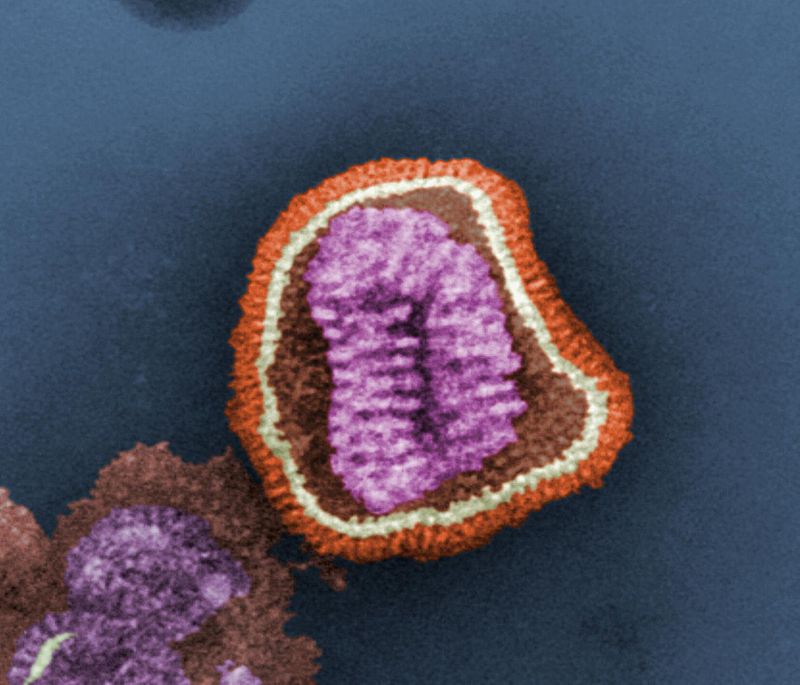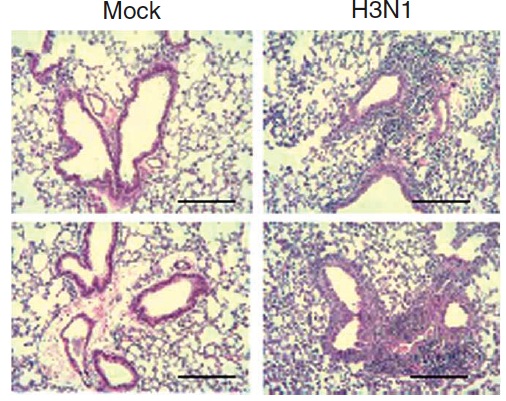
Asthma triggered by the influenza virus works through pathways not targeted by existing drugs. (Photo: Cynthia Goldsmith)
A case of the flu almost always exacerbates asthma, and often spells hospitalization for asthmatic children. But why is flu so dangerous, and why are flu-induced exacerbations so hard to control?
New research reveals that these attacks arise via a previously unrecognized physiologic pathway that appears to bypass existing asthma drugs.
“Virtually everyone who comes into the hospital with asthma has a viral infection, because we just can’t treat it well,” says Dale Umetsu, the study’s senior investigator and an immunologist at Children’s Hospital Boston. “If we could find better therapies that specifically target this pathway, we might be able to help these patients.”
The new study, using a mouse model of airway hyperreactivity, showed that influenza activates a newly recognized group of immune cells called natural helper cells, which then secrete asthma-inducing compounds. In contrast, most existing asthma-control drugs (like inhaled corticosteroids) act on a pathway involving TH2 cells, immune cells that are important in allergic asthma and have been a main focus of asthma research for the past three decades.
This insight suggests a new group of targets to develop drugs against: the natural helper cells themselves; IL-33, the compound that activates them once stimulated by influenza; or the compounds that the natural helper cells secrete.

The lung in uninfected mice (left) and after infection with influenza A (right). Courtesy Umetsu lab.
The research adds to the growing idea that asthma is a collection of different disease processes that all cause airways to become twitchy and constricted. You might call it a personalized medicine approach to asthma.
“We need to understand the specific asthma pathways present in each individual with asthma and when they are triggered, so we can give the right treatment at the right time,” Umetsu says.
Umetsu’s team showed in 2006, for example, that a third group of cells, known as natural killer T-cells (NKT cells), are also important in asthma, and demonstrated their presence in the lungs of asthma patients. In mice, NKT-cell activation alone is sufficient to cause asthma in response to exposure to ozone (a major air pollutant). Compounds targeting NKT cells are now in preclinical development.
Oddly enough, natural helper cells were first discovered in the intestines, where they were recently found to help combat parasitic worm infections.
“Since the lung is related to the gut – both are exposed to the environment – we asked if natural helper cells might also be in the lung and be important in asthma,” Umetsu says.
Subsequent experiments, led by Ya-Jen Chang and Hye Young Kim in Umetsu’s lab showed that these cells are indeed important in the lung in a mouse model of influenza-induced asthma — but not in allergic asthma.
Making matters more complicated, a single person might have two or more different asthma pathways. And there are other twists: For example, Umetsu’s team has identified a certain subset of NKT cells that actually seem to prevent allergic reactions in the airways if stimulated early in life by the right agents – including influenza A.
“You need the right balance of these different cell types, and we’re trying to understand how that balance occurs,” says Umetsu.






